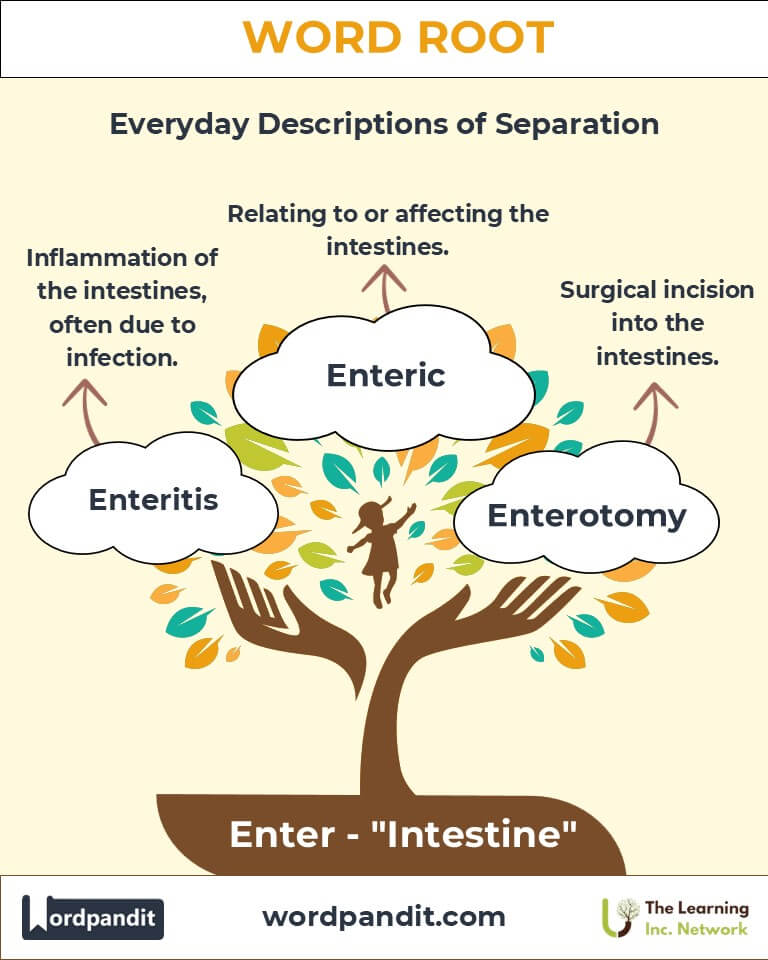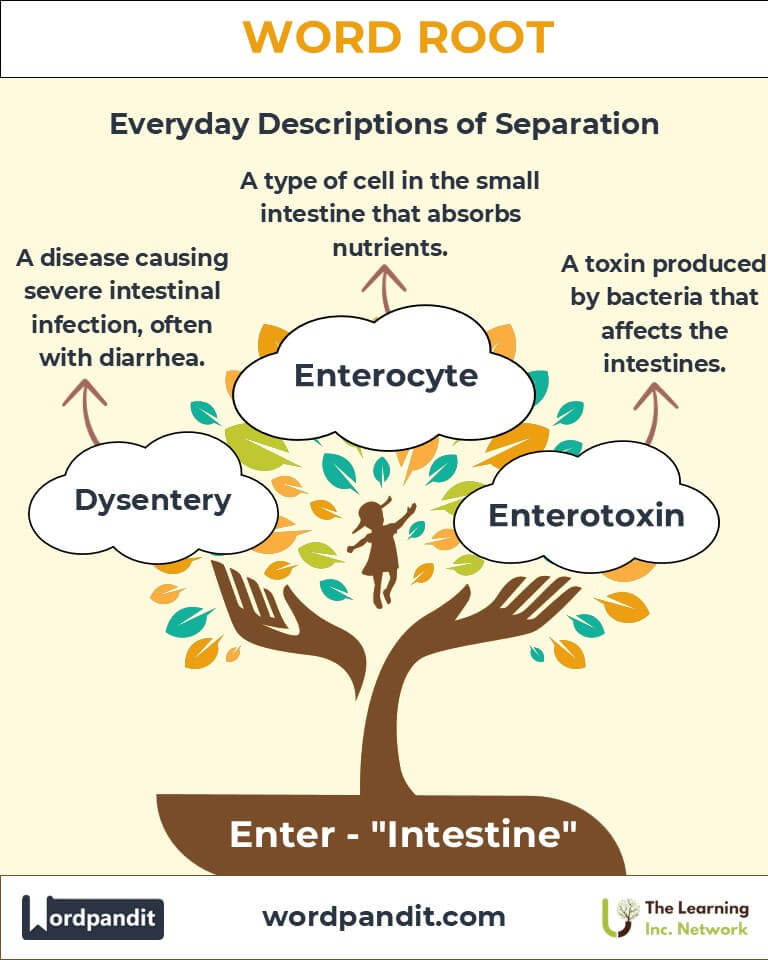Enter: The Root of Intestinal Significance in Medicine and Biology
Discover the deep connection between the root "enter," meaning "intestine," and its role in medical, biological, and everyday language. From describing conditions like "enteric" to exploring ancient history, this article unveils the rich legacy of this vital root.

Table of Contents
- Introduction: The Core of "Enter"
- Etymology and Historical Journey
- Mnemonic: Unlocking the Power of Enter
- Common Enter-Related Terms
- Enter Through Time
- Enter in Specialized Fields
- Illustrative Story: Enter in Action
- Cultural Significance of the Enter Root
- The Enter Family Tree
- FAQs About the Enter Word Root
- Test Your Knowledge: Enter Mastery Quiz
- Conclusion: The Enduring Role of Enter
1. Introduction: The Core of "Enter"
The word root "enter" (pronounced en-tur) stems from the Greek word enteron, meaning "intestine." This root is fundamental in the study of health, disease, and anatomy, influencing terms across medical and biological disciplines. From conditions affecting digestion to treatments targeting gut health, the legacy of "enter" highlights its critical role in human well-being.

2. Etymology and Historical Journey
The root "enter" originates from the Greek enteron (intestine), which was used extensively in ancient Greek medicine to describe internal organs. Over centuries, "enter" evolved into a core term in medical science, particularly in gastroenterology. As anatomical knowledge expanded during the Renaissance, "enter" became a prefix in various languages, signifying intestinal and digestive relevance.
3. Mnemonic: Unlocking the Power of Enter
Picture an intricate maze representing the human intestines, guiding nutrients through the body. The maze’s winding paths symbolize the complexity and centrality of the gut.
Mnemonic Device: "Enter the maze of the intestines—where digestion begins and sustains life!"
4. Common Enter-Related Terms
- Enteric (en-ter-ik): Relating to or affecting the intestines.
Example: "The vaccine is designed to combat enteric infections, such as typhoid fever." - Dysentery (dis-en-ter-ee): A disease causing inflammation of the intestines, often with severe diarrhea.
Example: "Dysentery outbreaks were common in ancient armies due to poor sanitation." - Enteritis (en-ter-eye-tis): Inflammation of the intestines, often caused by infection or irritation.
Example: "Enteritis symptoms include abdominal pain and diarrhea." - Enterotomy (en-ter-aw-toh-mee): A surgical procedure involving an incision into the intestines.
Example: "The surgeon performed an enterotomy to remove the obstruction." - Enterocyte (en-ter-oh-site): A type of cell lining the small intestine, crucial for nutrient absorption.
Example: "Enterocytes play a key role in breaking down food into usable nutrients."
5. Enter Through Time
- Enteric Fever
- Then: Historically, a broad term for illnesses like typhoid.
- Now: Specifically refers to bacterial infections affecting the intestines and bloodstream.
- Dysentery
- Then: A leading cause of death in ancient and medieval societies, often linked to poor hygiene.
- Now: Still a concern in areas with limited access to clean water, but treatable with modern medicine.
6. Enter in Specialized Fields
- Medicine: Term: Enteroscopy (examination of the intestines).
Relevance: Used to diagnose conditions like Crohn’s disease or tumors. - Microbiology: Term: Enterotoxin (toxins targeting the intestines).
Application: Explains mechanisms behind foodborne illnesses like E. coli infections. - Veterinary Science: Term: Enterolith (intestinal stone in animals).
Importance: Common in horses, these stones require surgical removal to prevent fatal blockages.
7. Illustrative Story: Enter in Action
Dr. Maria Patel, a gastroenterologist, treated a patient suffering from chronic abdominal pain. Using an enteroscopy, she identified inflammation caused by a rare enteric pathogen. After prescribing targeted antibiotics, the patient recovered swiftly, highlighting the indispensable role of "enter"-based technologies in saving lives.
8. Cultural Significance of the Enter Root
Historically, the intestines were considered a seat of health and emotion. Ancient Greeks believed gut health was directly tied to overall vitality, an idea echoed today with modern research into the gut-brain connection. Expressions like "gut feeling" and "visceral reaction" reflect this enduring cultural perspective.

9. The Enter Family Tree
- Gastro- (stomach): Gastroenterology—the study of the stomach and intestines.
- Colon- (large intestine): Colonoscopy—examination of the colon.
- Proct- (rectum/anus): Proctitis—inflammation of the rectum.

FAQs About the "Enter" Word Root
Q: What does "enter" mean?
A: "Enter" is a root word derived from the Greek enteron, meaning "intestine." It is widely used in medical terminology to denote conditions, processes, or structures related to the intestines, highlighting its vital role in digestion and nutrient absorption.
Q: What is the difference between "enteric" and "enteritis"?
A: "Enteric" refers to anything related to or affecting the intestines, such as enteric-coated pills designed to dissolve in the intestines instead of the stomach. "Enteritis" specifically denotes inflammation of the intestines, often caused by infections, irritants, or autoimmune conditions.
Q: What is dysentery, and how is it different from enteritis?
A: Dysentery is a severe intestinal infection characterized by diarrhea with blood and mucus, often caused by bacteria like Shigella or amoebas. While enteritis refers to general inflammation of the intestines, dysentery is a specific disease with distinct symptoms like fever, pain, and severe dehydration.
Q: What is the role of enterocytes in the digestive system?
A: Enterocytes are specialized cells lining the small intestine. They are responsible for absorbing nutrients like glucose, amino acids, and vitamins from digested food, making them essential for maintaining nutrition and overall health.
Q: Why are enteric-coated pills important in medicine?
A: Enteric-coated pills are designed to withstand stomach acid and dissolve only in the intestines. This ensures that drugs that can irritate the stomach or require intestinal absorption are delivered effectively and safely.
Test Your Knowledge: "Enter" Mastery Quiz
1. What does the root "enter" signify?
2. What does "enteric" refer to?
3. What is dysentery?
4. What is the primary function of enterocytes?
5. What does an enterotomy involve?
12. Conclusion: The Enduring Role of Enter
The root "enter" forms the backbone of words that define our understanding of intestinal health and disease. From historical challenges like dysentery to modern innovations in gastroenterology, "enter" bridges ancient wisdom and cutting-edge science. As research continues to unveil the gut's influence on overall health, this root remains central to medicine and biology, guiding us toward a healthier future.














